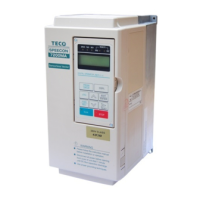93
(33) Multi-Function Analog Output (Terminal AO1) Selection (Sn-33)
(34) Multi-Function Analog Output (Terminal AO2) Selection (Sn-34)
•The multi-function analog output can be set to monitor the following 12 status
items as shown below:
Description
Sn-33, Sn-34
Setting
Monitored contents
Input Output
00 Frequency Command 0 ~ max. frequency
01 Output Frequency 0 ~ max. frequency
02 Output Current 0 ~ rated current
03 Output Voltage 0 ~ rated voltage
04 DC Voltage
220V class 0~400V
440V class 0~800V
05 VIN Analog Command 0 ~ 10 V
06 AIN Analog Command 4 ~ 20 mA
07 AUX Analog Command 0 ~ 10 V
08 PID Input 0 ~ max frequency
09 PID Output1 0 ~ max frequency
10 PID Output2 0 ~ max frequency
11 Comm. Control 0~100%
*1
0~10V
Note : *1: when the setting of Sn-33~34=’11’, the multi-function output terminals AO1, AO2 are
controlled through RS-485 port either by MODBUS or PROFIBUS protocol. Please refer to
“7200MA RS-485 MODBUS/PROFIBUS Application Manual”
•The output gain (Bn-14 and Bn-15) will determine the output voltage at multi-
function analog output at AO1, AO2 terminal. The specified multiple of 10V will
correspond to the 100% output monitored value.
(35) Pulse Output Multiplication-Gain Selection (Sn-35)
•If the multi-function output terminal (DO1) be set as pulse output (when Sn-31 or
Sn-32= 14),the final output pulse frequency is the multiple (according to Sn-35) of
the inverter output frequency. Refer to Fig. 46 for pulse signal output.
•Ex1 : when Sn-35= 0, the inverter output frequency is 60Hz, the output pulse
frequency is 60 Hz (duty = 50%).
•Different settings of Sn-35 and their corresponding multiple numbers as shown
below :
Sn-35 setting Pulse output frequency Applicable freq. range
01F
:
1
×
inverter output frequency 3.83
∼
400.0Hz
16F
:
6
×
inverter output frequency 2.56
∼
360.0Hz
2 10F
:
10
×
inverter output frequency 1.54
∼
210.0Hz
3 12F
:
12
×
inverter output frequency 1.28
∼
180.0Hz
4 36F
:
36
×
inverter output frequency 0.5
∼
60.0Hz

